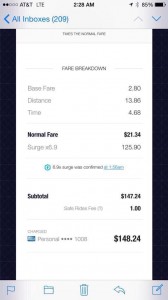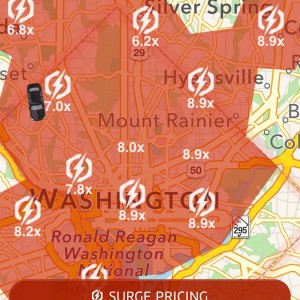UberFail - a few thoughts on Uber
To lose one parent, Mr. Worthing, may be regarded as a misfortune; to lose both looks like carelessness. _ Oscar Wilde, The Importance of Being Earnest
Some thoughts on Uber, some blindingly obvious. I’ll say at the outset that I think Uber is a 10x improvement on existing cabs, and I have no problem in principle with a supply/demand based surge pricing model. But here goes…
1) Uber doesn’t have it together operationally.
Exhibit 1: Outraged passengers post bills online.

Exhibit 2: Outraged drivers say they couldn’t find passengers and it didn’t pay to work on New Year’s Eve. Also on Reddit.
Exhibit 3: Combining 1 and 2 into a singularity of Uber-fail, some drivers said that even as the map showed a huge pricing surge presumably due to overwhelming demand, they couldn’t get passengers. Apparently the surge drove passengers away…or in any event something was awry.
If you’re managing to piss off the riders because they’re feeling gouged, and drivers who feel they’re being taken advantage of, well, that seems less like misfortune and griping, and more like carelessness in running the system.
2) The frequent surges seem rather extreme. Hotels might have a 10x change in price from bottom of low season to the peak convention season. But…hotel room supply is perfectly inelastic in the short run. Uber, in most cities, should be able to tap casual drivers and get many more cars on the road at peak times. Car rides should be closer to other seasonal products and services like airfares, where maybe you see a 3x differential on a peak date.
Maybe, over time they’ll have more data and get better at forecasting demand on the one hand. And drivers and passengers will understand the system better and not get shocked and outraged. But…
3) There is very limited transparency, and data for riders and drivers to plan ahead. A fundamental problem with Uber’s surge pricing model is that it is a black box, and seems self-serving to Uber.
Even Uber’s exceptional pre-NYE blog was of limited value in providing actionable data about how high the surge was expected to go, beyond don’t travel between 12 and 2. (And they didn’t even provide lip service as to how they were working to get as many drivers as possible on the road to limit the surge, which is tone-deaf).
When they surge and then drivers sit around doing nothing, either the algorithm is crap, or they are raising prices on a hair-trigger whenever they think they can to maximize revenue, which clearly would be in their financial interest.
Consider one extreme _ the algorithm always adjusts price as much as necessary to keep a 1-minute wait. Or the other extreme _ no adjustment _ and wait times go up. Well, some passengers might prefer a brief queue. But clearly, maximizing revenue is to Uber’s advantage.
Say your time is worth $30 an hour. Presumably you would be indifferent between a price with $15 dispersion and a wait time with 30 minutes dispersion. In fact the wait time might be easier to plan for, if it looks busy you call for the car 15 minutes before your dinner is over, maybe you have to rush out a little earlier, maybe you linger a little later. You’ll be happier with that than the current price dispersion with up to 9x surges on New Year’s Eve.
4) Uber wants to maximize profitability, but both drivers and riders value predictability. (see Steve Randy Waldman’s excellent discussion). Economists sometimes (not always) have a blind spot in only considering efficiency in terms of price and quantity. But of course, behaviorally, whenever something unexpected happens, it leads to unhappiness and inefficiency beyond the purely financial cost. Loss-aversion kicks in, and you feel gouged when you expected to pay $10 and had to pay $50 through no fault of your own. Maybe you don’t take a $20 round trip that would otherwise make sense, because you’re not sure if it will turn out to cost $50 to get back.
So I think that 1) Uber’s execution, even though outstanding in many respects, has room to improve, and 2) their market design is not ideal from a consumer standpoint.
5) Without further ado, here are some things Uber could do to improve:
- Provide transparency on the algorithm used to set surge pricing. Provide data on number and location of drivers and riders in real time. Do a Netflix-style competition on finding the optimal market-clearing model.
- Let you put in for a reservation hours or days in advance, and let drivers commit to pick up a reservation. You have a time and price guarantee, Uber has a valuable signal in advance on demand. And the driver gets predictability.
- Uber’s slogan “Everyone’s private driver” becomes more literally true if people can request specific drivers in advance.
- Make the surge pricing a true live auction. Let the rider say how much they are willing to pay, and Uber provides an estimate of how much of a wait that will give them, according to how many higher-paying riders are ahead of them. In other words, give the rider a choice _ wait for an available car, with a predicted queuing time. Or bid a surge price to jump the queue. Then it is a true auction with transparency.1</small> [Edit: you could even bid below the normal price, if anyone’s available off-peak to run a retiree to the drug store for 30% off, notify me.].
Today, the model is Uber attempting to have their cake and eat it too _ pretend they’re a two-way market while acting as a cartel to maximize revenue. - (Pipe dream) Charge their fee only on the non-surged rate. Otherwise it may be in their interest to surge, even when it hurts drivers and riders.
- Push UberPOOL sharing _ give people a prominent button to offer/accept ride shares to destinations along their route. For many people, sharing is a better alternative to bidding the price up or waiting.
- (Pipe dream) Eliminate anticompetitive ToS terms _
let drivers join all services, allow open APIs for drivers to advertise their availability across multiple services, allow APIs to let riders to check all services from one app. [Edit: I haven’t reviewed the driver agreement-I just assumed Uber would do everything possible to make it as sticky as possible for drivers to switch.]</ul> If you have transparency, rider choice, and no anticompetitive and uber-aggressive tactics, that will go a long way toward improving rider and driver satisfaction.
Uber really doesn’t have it together on messaging: see the Uber-gate fiasco. (Even if Sarah Lacy and Pando have latched on to the anti-Uber angle and are prone to their own threatening meltdowns, Travis Kalanick can come across as a high-functioning psychopath. Here’s a balanced discussion, which I think pulls some punches over the narcissistic hacks at Pando.)
You might say this is beating a horse to death, it’s just a friggin’ car service.
Since we can now do complex market designs with networked smartphones, a lot of things are going to get allocated that way. It probably makes sense to put a little thought in how to come up with good market designs that make people happy. It would be pretty miraculous if Uber got the perfect design on the first try. If both drivers and customers are mad at Uber, it might be worth thinking about how to do it better, and not leave it to
rapaciousaggressive entrepreneurs and grasping politicos.If Uber can come up with market designs that allocate scarce perishable resources in real time more efficiently and make people happier, that’s applicable in a lot of areas and worth far more than the taxi industry they’re disrupting. It’s a hundreds-of-billions of dollars type of problem.2
Hailing from an app is a 10x user experience improvement v. trying to hail from the street…you get your car faster, don’t have to wait on a street-corner with your hand out…it reduces empty cruising, which costs money and increases congestion…with some more thought, we can increase car pooling and let multiple people share rides.
Maybe the runt competitors like Lyft and prospect of competition will keep Uber from abusing its market position and extracting rents. My guess is, it’s more likely it becomes a Google or Amazon-type winner-take-all market. The biggest brand has a big, but maybe not insuperable advantage in attracting riders and drivers, and I would expect them to do everything possible to not become a commoditized airline ticket market, unless regulators force them too. Maybe that would be a good thing, as Waldman argues. But it would be a shame if ‘disruption’ just meant we went from a medallion cartel to a new tech cartel that extracted all the value from the technological improvement.
1In fairness, the practicality of a true live auction could turn out to be questionable. People may not want an Ebay or stock trader experience every time they take a cab. And the ultimate pricing outcome might not be that different from what it is now. When demand is high, bid high or don’t get a cab at all. Right at the marginal price one might save a few bucks by waiting. And there would still be volatility. And some customers fat-fingering their interactions with the system, or feeling gouged regardless. The key issue is transparency and a true sense that the price is supply and demand-driven. It might take a lot of product design / UI creativity to make a true live auction workable without defaulting a lot of user input to automatic defaults, but a black box clearing system seems hard to justify.
2Valuation of NYC taxi medallions: ~$13b. Uber valuation: ~$40b. I’m just sayin’… To those who think it’s a crazy bubble, there is a really big market opportunity here.

